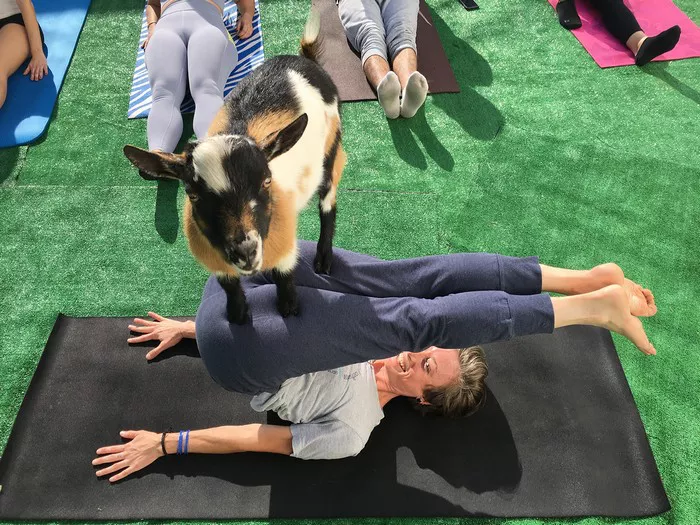In recent years, the wellness trend of goat yoga has gained significant popularity, captivating participants with its unique blend of yoga and animal interaction. Originating in 2016, goat yoga combines traditional yoga poses with the presence of live goats, allowing practitioners to engage in their practice amidst the playful antics of these adorable animals. As the name suggests, goats freely roam around the yoga session, sometimes climbing on participants’ backs or simply providing a lively and unconventional backdrop to the practice.
Ethical Considerations
The surge in interest surrounding goat yoga prompts important questions regarding its ethical implications. Central to this inquiry is the treatment of the goats involved. Critics express concerns about whether these animals are subjected to stress or exploitation for the sake of human entertainment. Additionally, there is scrutiny over the living conditions of the goats and whether their welfare is adequately prioritized during these sessions.
Animal Welfare Standards
To assess the ethicality of goat yoga, it’s crucial to understand the prevailing animal welfare standards. Various organizations, such as the American Veterinary Medical Association (AVMA) and the Animal Welfare Institute (AWI), have established guidelines aimed at safeguarding the well-being of animals in human care. These standards encompass factors such as access to clean water and appropriate shelter, as well as provisions for proper nutrition and veterinary care.
In the context of goat yoga, responsible practitioners adhere to these principles by ensuring that participating goats are well-fed, hydrated, and provided with suitable resting areas. Furthermore, reputable goat yoga facilities prioritize the goats’ comfort and monitor their behavior to prevent any undue stress or discomfort during sessions.
Pros and Cons
Advocates of goat yoga extol its potential benefits, citing studies that suggest interactions with animals can reduce stress and promote overall well-being. Proponents argue that goat yoga offers a unique form of animal-assisted therapy, fostering connections between humans and animals while enhancing the yoga experience.
However, critics raise valid concerns about the potential stress and exploitation of goats in these settings. While some goats may enjoy the attention and interaction, others might find the experience distressing or uncomfortable. Moreover, there’s a risk of trivializing the animals’ presence, reducing them to mere props for human entertainment rather than respecting them as sentient beings with their own needs and preferences.
Expert Opinions
Insights from experts in various fields shed light on the ethical complexities of goat yoga. Animal behaviorists emphasize the importance of understanding goat behavior and body language to ensure their well-being during yoga sessions. Ethicists urge practitioners to consider the broader implications of using animals for recreational purposes, emphasizing the need for consent and respectful treatment.
Yoga practitioners with experience in goat yoga offer valuable perspectives on balancing enjoyment with responsibility. Many emphasize the need for mindful interaction with the goats, respecting their boundaries and allowing them to participate voluntarily. Additionally, some practitioners advocate for transparency regarding the goats’ living conditions and treatment, enabling participants to make informed choices about their involvement.
Anecdotal Evidence
Personal accounts from individuals who have participated in goat yoga provide valuable insights into the dynamics of these sessions. Many describe feeling uplifted and rejuvenated by the presence of the goats, noting the joy and laughter they bring to the practice. Participants often share anecdotes of goats spontaneously joining them in yoga poses or nuzzling them affectionately, fostering a sense of connection and camaraderie.
However, not all experiences are uniformly positive. Some participants express concerns about overcrowded or chaotic sessions, where goats may become overwhelmed or overstimulated. Additionally, there are occasional reports of goats exhibiting signs of stress or discomfort, prompting reflection on the ethical implications of their participation.
Guidelines for Ethical Practice
For those considering participating in goat yoga, it’s essential to seek out facilities that prioritize the well-being of the animals involved. Look for establishments that provide ample space for the goats to roam and retreat if needed, as well as access to fresh food and water. Additionally, inquire about the training and supervision of staff members responsible for the goats’ care during sessions.
During the yoga practice itself, remain mindful of the goats’ cues and boundaries, avoiding any actions that could cause them distress or discomfort. Respect their autonomy and allow them to engage with participants on their own terms. By approaching goat yoga with sensitivity and respect for the animals involved, practitioners can enjoy the experience while upholding ethical standards.
Alternatives to Goat Yoga
For those who are concerned about the ethical implications of goat yoga but still seek the therapeutic benefits of animal-assisted activities, there are alternative practices to consider. Equine-assisted therapy, for example, involves interacting with horses in a therapeutic setting, offering similar opportunities for human-animal bonding without the potential stress of goat yoga. Additionally, nature-based yoga practices, such as outdoor sessions surrounded by natural landscapes, provide opportunities for connection with the environment and wildlife in a more sustainable and respectful manner.
Conclusion
In the debate surrounding the ethics of goat yoga, it’s essential to strike a balance between enjoyment and responsibility. While goat yoga offers unique opportunities for human-animal interaction and holistic well-being, it also raises important questions about the treatment and welfare of the goats involved. By adhering to animal welfare standards, listening to expert opinions, and practicing mindfulness and respect during sessions, practitioners can participate in goat yoga ethically, ensuring a positive experience for both humans and goats alike.
















